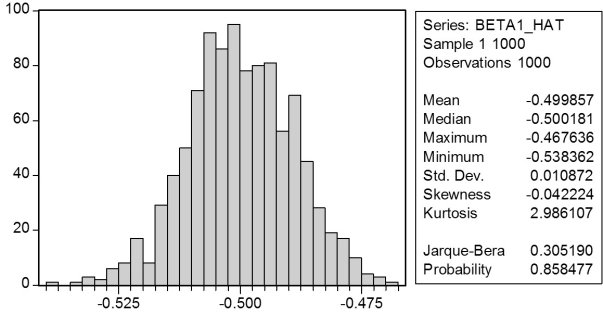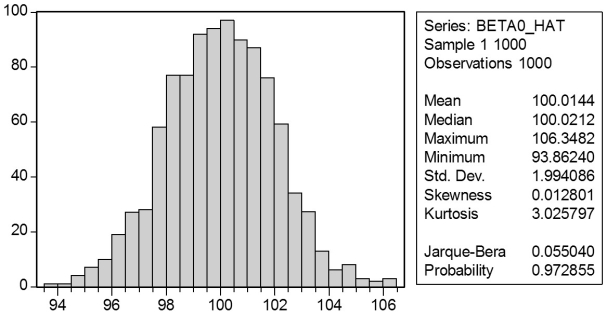Essay
In a Monte Carlo study, econometricians generate multiple sample regression functions from a known population regression function. For example, the population regression function could be Yi = ?0 + ?1Xi = 100 - 0.5 Xi. The Xs could be generated randomly or, for simplicity, be nonrandom ("fixed over repeated samples"). If we had ten of these Xs, say, and generated twenty Ys, we would obviously always have all observations on a straight line, and the least squares formulae would always return values of 100 and 0.5 numerically. However, if we added an error term, where the errors would be drawn randomly from a normal distribution, say, then the OLS formulae would give us estimates that differed from the population regression function values. Assume you did just that and recorded the values for the slope and the intercept. Then you did the same experiment again (each one of these is called a "replication"). And so forth. After 1,000 replications, you plot the 1,000 intercepts and slopes, and list their summary statistics.
Here are the corresponding graphs: 
 Using the means listed next to the graphs, you see that the averages are not exactly 100 and -0.5. However, they are "close." Test for the difference of these averages from the population values to be statistically significant.
Using the means listed next to the graphs, you see that the averages are not exactly 100 and -0.5. However, they are "close." Test for the difference of these averages from the population values to be statistically significant.
Correct Answer:

Verified
You can use a simple t-statistic to calc...View Answer
Unlock this answer now
Get Access to more Verified Answers free of charge
Correct Answer:
Verified
View Answer
Unlock this answer now
Get Access to more Verified Answers free of charge
Q1: The p-value for a one-sided left-tail test
Q2: Finding a small value of the p-value
Q3: Assume that the homoskedastic normal regression assumption
Q4: With heteroskedastic errors, the weighted least squares
Q6: Carefully discuss the advantages of using heteroskedasticity-robust
Q7: Using the textbook example of 420 California
Q8: Under the least squares assumptions (zero conditional
Q9: In the presence of heteroskedasticity, and assuming
Q10: (Requires Appendix material from Chapters 4
Q11: Your textbook discussed the regression model